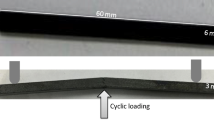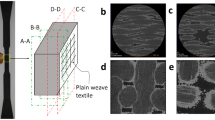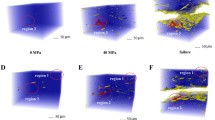Abstract
The damage evolution and fracture behavior in the bulk of C/SiC material under monotonic tensile loading have been investigated with the 3D in-situ observations by using X-ray CT. Crack initiated inside the matrix within 0.02 mm below surface when the load was only 19% of the failure strength, and propagated to the surface of matrix and towards the interior of specimen by breaking fibers and matrix when the load was above the elastic limit. With the further increasing of loading, other fiber breaks, matrix breaks and delaminations were observed to initiate and propagate both on the surface and in the bulk of specimen, while the cracks nucleating in the bulk of specimen are generally located at the laminae with a high volume fraction of pores. With the further propagations of cracks, the specimen split in the laminae with a large quantity of pores, while the fiber drawings results in the final fracture in the laminae without a large quantity of pores. The novel method being proposed to characterize the distribution of pores in this paper highlights the relation between the distribution of pores in the bulk of the studied material and cracks initiations and final fracture.








Similar content being viewed by others
Notes
The fiber bundle parallel to the loading direction is called as “0° fiber bundle”, while the fiber bundle perpendicular to the loading direction is called as “90° fiber bundle”.
References
Mei, H., Han, D., Farhan, S., Cheng, L., Xu, H., Liu, Y.: Impact behavior of different cross-ply laminated carbon fiber-reinforced silicon carbide composites under the low velocity. J. Compos. Mater. 50, 1137–1142 (2015)
Xu, Y., Ren, S., Zhang, W.: Thermal conductivities of plain woven C/SiC composite: Micromechanical model considering PyC interphase thermal conductance and manufactureinduced voids. Compos. Struct. 193, 212–223 (2018)
Yang, W., Zhang, L., Cheng, L., Liu, Y., Cheng, L., Zhang, W.: Oxidation behavior of C/SiC composite with CVD SiC-B4C coating in a wet oxygen environment. Appl. Compos. Mater. 16, 83–92 (2009)
Zhao, L., Yang, W., Cao, T., Li, H., Liu, B., Zhang, C., Zhang, J.: A progressive failure analysis of all-C/SiC composite multi-bolt joints. Compos. Struct. 189, 378–385 (2018)
Naslain, R.: Design, preparation and properties of non-oxide CMCs for application in engines and nuclear reactors: an overview. Compos. Sci. Technol. 64, 155–170 (2004)
Liu, Y., Cheng, L., Zhang, L., Yang, W., Zhou, S., Zhang, W.: Abrication and mechanical behaviors of 2D C/SiC–BCx composite at room temperature. J. Compos. Mater. 46, 1251–1260 (2011)
Bale, H.A., Haboub, A., MacDowell, A.A., Nasiatka, J.R., Parkinson, D.Y., Cox, B.N., Marshall, D.B., Ritchie, R.O.: Real-time quantitative imaging of failure events in materials under load at temperatures above 1600°C. Nat. Mater. 12(1), 40–46 (2013)
Marshall, David, Cox, Brian, Kroll, Peter, Hilmas, Greg, Fahrenholtz, William, Raj, Rishi, Ritchie, Robert, Yang, Qingda, Zok, Frank. National Hypersonic Science Center for Materials and Structures. AD report, (2014)
Wang, L., Yuan, K., Luan, X., Li, Z., Feng, G., Jianguo, W.: 3D characterizations of pores and damages in C/SiC composites by using X-ray computed tomography. Appl. Compos. Mater. 26, 493–505 (2019)
Feng, Y., Feng, Z., Li, S., Zhang, W., Luan, X., Liu, Y., Cheng, L., Zhang, L.: Micro-CT characterization on porosity structure of 3D Cf/SiCm composite. Compos. Part A. 42, 1645–1650 (2011)
Salvo, L., Suéry, M., Marmottant, A., Limodin, N., Bernard, D.: 3D imaging in material science: application of X-ray tomography. Comptes Rendus Phys. 11, 641–649 (2010)
Wang, L., Guolin, F., Zhiqiang, L., Wu, J., Wei, Z.: Applications of X-ray computed tomography to study the mechanical behaviors of materials. Struct. Environ. Eng. 44, 43–56 (2017)
Buffiere, J.-Y., Maire, E., Adrien, J., Masse, J.-P., Boller, E.: In-situ experiments with X ray tomography: an attractive tool for experimental mechanics. Exp. Mechan. 50, 289–305 (2010)
Maire, E., Zhou, S., Adrien, J., Dimichiel, M.: Damage quantification in aluminium alloys using in situ tensile tests in X-ray tomography. Eng. Fract. Mech. 78, 2679–2690 (2011)
Wang, L., Limodin, N., El Bartali, A., Witz, J.-F., Seghir, R., Buffiere, J.-Y., Charkaluk, E.: Influence of pores on crack initiation in monotonic tensile and cyclic loadings in lost foam casting A319 alloy by using 3D in-situ analysis. Mater. Sci. Eng. A. 673, 362–372 (2016)
Proudhon, H., Buffière, J.-Y., Fouvry, S.: Three-dimensional study of a fretting crack using synchrotron X-ray micro-tomography. Eng. Fract. Mech. 74, 782–793 (2007)
Limodin, N., El Bartali, A., Wang, L., Lachambre, J., Buffière, J.-Y., Charkaluk, E.: Application of X-ray microtomography to study the influence of the casting microstructure upon the tensile behaviour of an Al-Si alloy. Nucl. Instrum. Methods Phys. Res. Sec. B: Beam Interact. Mater. Atoms. 324, 57–62 (2014)
Wu, S.C., Xiao, T.Q., Withers, P.J.: The imaging of failure in structural materials by synchrotron radiation X-ray microtomography. Eng. Fract. Mech. 182, 127–156 (2017)
Xie, N., Smith, R.A., Mukhopadhyay, S., et al.: A numerical study on the influence of composite wrinkle defect geometry on compressive strength. Mater. Des. 140, 7–20 (2018)
Liu, T., Sun, B., Bohong, G.: Influence of specimen size and inner defects on high strain rates compressive behaviors of plain woven composites. Polym. Test. 64, 55–64 (2017)
Buljac, A., Jailin, C., Mendoza, A., Neggers, J., Taillandier-Thomas, T., Bouterf, A., Smaniotto, B., Hild, F.: Digital volume correlation: review of progress and challenges. Exp. Mech. 58(5), 661–708 (2018)
Pan, B., Wu, D., Wang, Z.: Internal displacement and strain measurement using digital volume correlation: a least-squares framework. Meas. Sci. Technol. 23, 045002 (2012)
Bacaicoa, I., Wicke, M., Luetje, M., Zeismann, F., Brueckner-Foit, A., Geisert, A., Fehlbier, M.: Characterization of casting defects in a Fe-rich Al-Si-Cu alloy by microtomography and finite element analysis. Eng. Fract. Mech. 183, 159–169 (2017)
Acknowledgments
The authors would like to thank Dr. Daxu Zhang (Shanghai Jiaotong University, Shanghai, China) for providing the in-situ loading rig.
Author information
Authors and Affiliations
Corresponding author
Additional information
Publisher’s Note
Springer Nature remains neutral with regard to jurisdictional claims in published maps and institutional affiliations.
Highlights
• The damage evolution and fracture behavior in the bulk of C/SiC material under monotonic tensile loading have been investigated with the 3D in-situ observations by using X-ray CT.
• Crack initiated inside the matrix within 0.02 mm below surface when the load was only 19% of the failure strength, and propagated to the surface of matrix and towards the interior of specimen by breaking fibers and matrix when the load was above the elastic limit.
• A novel method being proposed to characterize the distribution of pores in this paper highlights the relation of the distribution of pores in the bulk of the studied material to crack initiation and final fracture.
Rights and permissions
About this article
Cite this article
Wang, L., Zhang, W., Li, H. et al. 3D In-Situ Characterizations of Damage Evolution in C/SiC Composite under Monotonic Tensile Loading by Using X-Ray Computed Tomography. Appl Compos Mater 27, 119–130 (2020). https://doi.org/10.1007/s10443-020-09796-5
Received:
Accepted:
Published:
Issue Date:
DOI: https://doi.org/10.1007/s10443-020-09796-5




